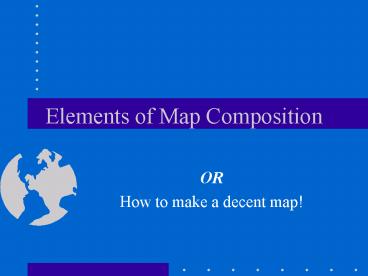Elements of Map Composition - PowerPoint PPT Presentation
1 / 32
Title:
Elements of Map Composition
Description:
Composition. You have all the data (coverages, shapes) You have the symbolization plan ... Arrangement of composition parts. Where to put borders, neatlines ... – PowerPoint PPT presentation
Number of Views:282
Avg rating:3.0/5.0
Title: Elements of Map Composition
1
Elements of Map Composition
- OR
- How to make a decent map!
2
Steps to Creating a Map
- Define the Purpose of the map
- Restatement into a design problem
- Visualization to Creation
- Design solution - arrangement of maps image
elements to facilitate communication - Sort of an outline
- Graphic design
3
Elements of a thematic map
- Title
- Legend
- Scale
- Credits
- Mapped and unmapped areas
- Graticule
- Borders and neatlines
- Symbols
- Place names and labels
4
Title
Mapped Area
Unmapped Area
Border or Neatline
Legend
No Place Names -(
Neatline
Text box
Gradicule
Graphic Scale
Credits
5
The elements one-by-one
- Title
- Draws attention by virtue of its size (big!)
- focuses attention on primary purpose of content
of map - not always needed
- Legend
- Principle reference to symbology
- MUST be there
6
The elements one-by-one
- Scale
- A MUST!
- Types
- graphic -- the bar
- verbal -- 1 1 mile (Not good now because too
many people copy maps and Xerox machines will
change the scale) - a ratio 1/24,000 (Not good either although it
may indicate accuracy) - Because of ubiquitous nature of Xerox machines
the graphic scale is a must, the others are
optional
7
The elements one-by-one
- Credits
- another, older, term for metadata
- Some metadata can be placed on map
- data source
- statement of accuracy, both spatial and attribute
- date data collected, date map made
- your name, assignment etc
8
The elements one-by-one
- Mapped and unmapped areas
- Objects, land, water, and other geographical
features important to the purpose of the map - makes the composition a map rather than a diagram
- Graticule
- a grid
- Often omitted
- useful if location info is important and there
are no features like roads or steams - The Graticule CAN take up space and thus reduce
white space and change balance (see later)
9
The elements one-by-one
- Borders and neatlines
- Optional around map elements
- Not optional (usually) around the entire
composition because it ties the parts of the
composition together! - Borders serve to restrain eye movement
- Neatlines are
- finer than borders
- drawn inside borders
- mainly decoration
10
The elements one-by-one
- Symbology
- can be actual symbols (style of city point)
and/or colors and patterns - most important part of map -- if user does not
know what the symbolization is the map is useless - Designer has little control over placement
(location should be as accurate as possible given
scale) but can control size and color
11
The elements one-by-one
- Place names and labels
- Primary means of communicating to user
- Orients user on map (similar to Graticule)
- Can provide important info re map purpose
12
Composition
- You have all the data (coverages, shapes)
- You have the symbolization plan
- Now you have to visualize the map
- A creative process
- Trial and error process
- Arrangement of composition parts
- Where to put borders, neatlines
- what style of borders, neatlines
13
Composition
- Purpose of composition
- Forces designer or organize the visual material
- Stresses the purpose of the map
- Directs the users attention
- Develops an aesthetic approach for the map
14
Compositon Planar Organization
- Balance
- visual impact of arrangement
- is the map heavy at top, bottom, sides???
15
Visual weight
- depends on location
- obj near center has less weight
- obj weight increases with distance from center
- obj at top are heavier than those at bottom
- obj on right are heavier than those on left
- depends on size (Duh!)
- depends on color, interest, and isolation
- RedgtBlue, Brightgtdark
- complex gt simple
- isolated gt groups
16
(No Transcript)
17
Unequal divisions of space more interesting than
equal divisions
18
Which is better balanced?
19
More Visual Balance
20
Movement of readers eye - upper left to lower
right
Field
Focus
21
Using Eye Movement
Eye goes left to right! Map?Legend
22
St. Louis too far from visual center, balance not
bad, however
Better, but a little heavy on right
23
Location of St, Louis
Legend -adf asdf adfafffdsf
Neatline around map part make for better balance
24
Location of St, Louis
Legend -adf asdf adfafffdsf
25
The grid of dots is there because I copied the
layout window with Paint Shot Pro and it captured
all the dots too. If you save the compositon it
will no contain the dots
26
Different Arrangements of composition features
27
Size / white space problems
28
Text
- Use mixture of upper and lower case
- ALL UPPER CASE IS HARDER TO READ
- Use sans serif text
- No fancy fonts
- Big print for important stuff
- Little print for not so important stuff
29
Using Color
- Color is tricky
- There are definite color preferences
- There are definite color combination preferences
- There are standard color codes (like for
planning)
30
ArcViews colors
31
So
- Creating maps is a creating a document for a
specific purpose -- to communicate something to
the reader - It is an iterative process
- There are some basic rules or guides that can be
used
32
Our Evaluation Criteria
- Spelling, title(concise), credit (name) -7 pts.
- Scale, north arrow, legend - 6 pts.
- Boundaries - 6 pts
- Balance,Color, Choice of symbol, labels (limited)
- 6 pts.































